Key Areas of Business Operations: Factors for Small Business, CRM, Transnational Development, Break-Even Analysis, Financial Statements and Interpretation of TESCO Plc. Final Accounts
VerifiedAdded on 2023/06/17
|17
|3694
|106
AI Summary
This report covers key areas of business operations including factors for small business, CRM, transnational development, break-even analysis, financial statements, and interpretation of TESCO Plc. final accounts. It also includes a discussion of laws affecting small businesses.
Contribute Materials
Your contribution can guide someone’s learning journey. Share your
documents today.
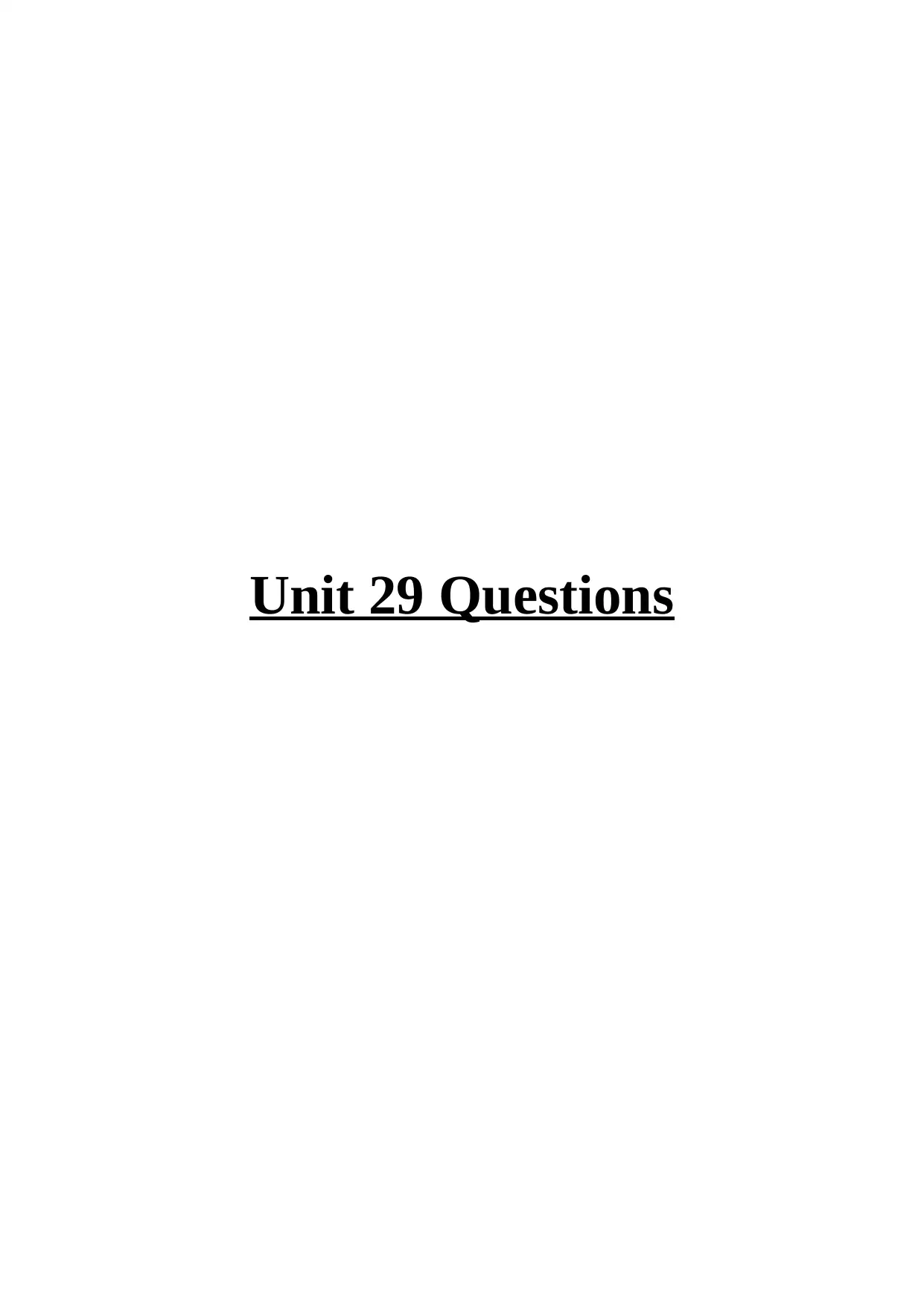
Unit 29 Questions
Secure Best Marks with AI Grader
Need help grading? Try our AI Grader for instant feedback on your assignments.
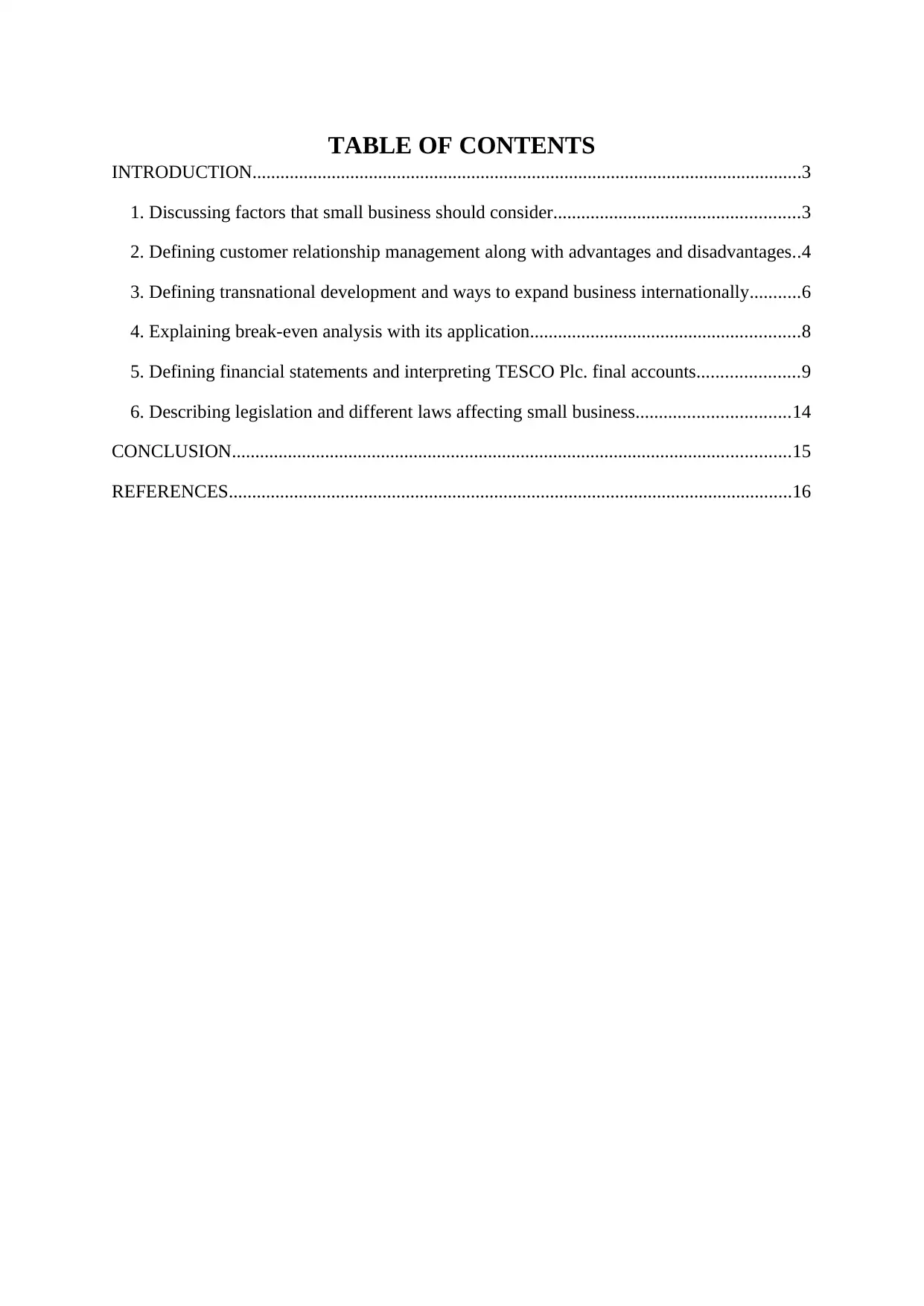
TABLE OF CONTENTS
INTRODUCTION......................................................................................................................3
1. Discussing factors that small business should consider.....................................................3
2. Defining customer relationship management along with advantages and disadvantages..4
3. Defining transnational development and ways to expand business internationally...........6
4. Explaining break-even analysis with its application..........................................................8
5. Defining financial statements and interpreting TESCO Plc. final accounts......................9
6. Describing legislation and different laws affecting small business.................................14
CONCLUSION........................................................................................................................15
REFERENCES.........................................................................................................................16
INTRODUCTION......................................................................................................................3
1. Discussing factors that small business should consider.....................................................3
2. Defining customer relationship management along with advantages and disadvantages..4
3. Defining transnational development and ways to expand business internationally...........6
4. Explaining break-even analysis with its application..........................................................8
5. Defining financial statements and interpreting TESCO Plc. final accounts......................9
6. Describing legislation and different laws affecting small business.................................14
CONCLUSION........................................................................................................................15
REFERENCES.........................................................................................................................16
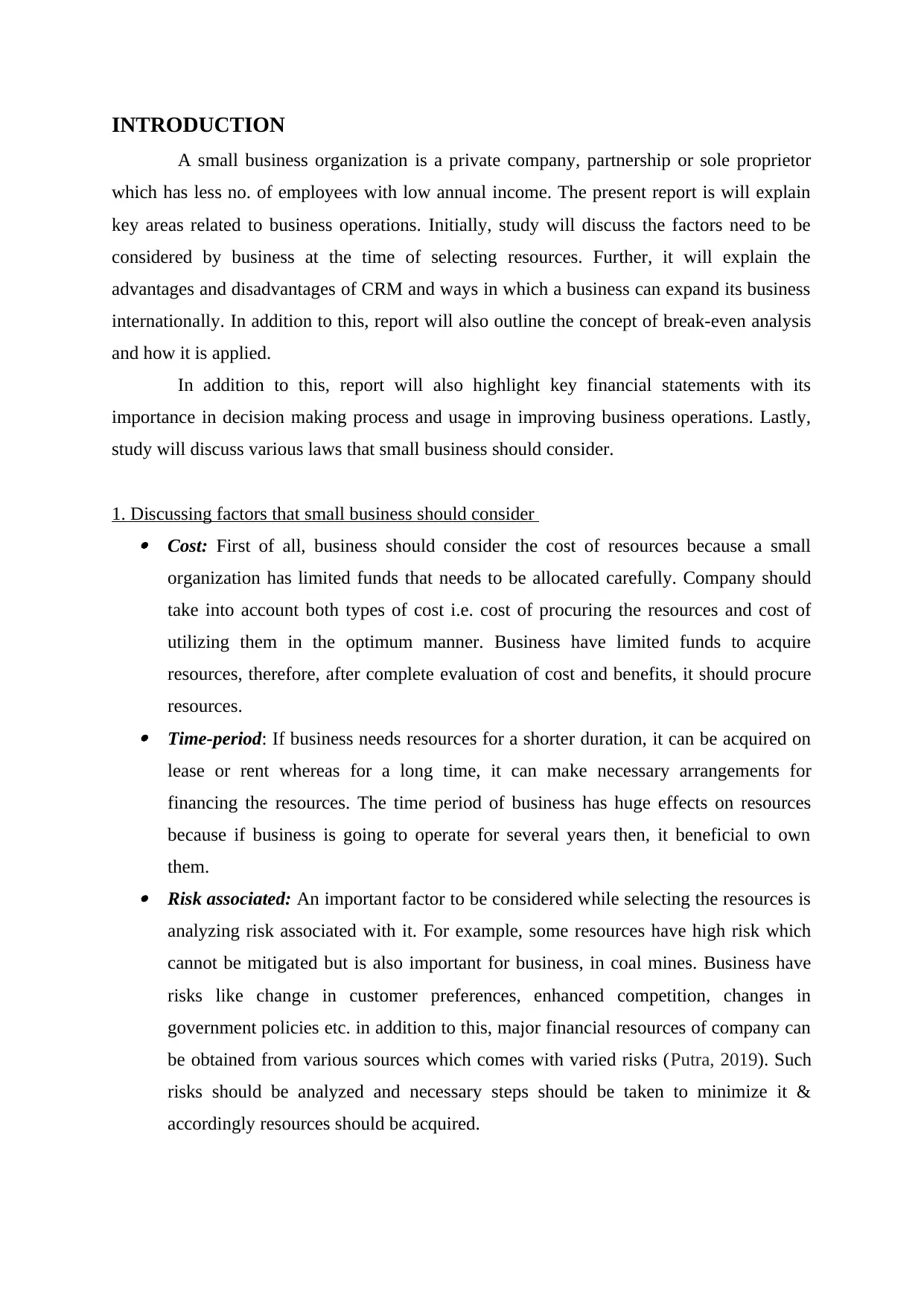
INTRODUCTION
A small business organization is a private company, partnership or sole proprietor
which has less no. of employees with low annual income. The present report is will explain
key areas related to business operations. Initially, study will discuss the factors need to be
considered by business at the time of selecting resources. Further, it will explain the
advantages and disadvantages of CRM and ways in which a business can expand its business
internationally. In addition to this, report will also outline the concept of break-even analysis
and how it is applied.
In addition to this, report will also highlight key financial statements with its
importance in decision making process and usage in improving business operations. Lastly,
study will discuss various laws that small business should consider.
1. Discussing factors that small business should consider Cost: First of all, business should consider the cost of resources because a small
organization has limited funds that needs to be allocated carefully. Company should
take into account both types of cost i.e. cost of procuring the resources and cost of
utilizing them in the optimum manner. Business have limited funds to acquire
resources, therefore, after complete evaluation of cost and benefits, it should procure
resources. Time-period: If business needs resources for a shorter duration, it can be acquired on
lease or rent whereas for a long time, it can make necessary arrangements for
financing the resources. The time period of business has huge effects on resources
because if business is going to operate for several years then, it beneficial to own
them. Risk associated: An important factor to be considered while selecting the resources is
analyzing risk associated with it. For example, some resources have high risk which
cannot be mitigated but is also important for business, in coal mines. Business have
risks like change in customer preferences, enhanced competition, changes in
government policies etc. in addition to this, major financial resources of company can
be obtained from various sources which comes with varied risks (Putra, 2019). Such
risks should be analyzed and necessary steps should be taken to minimize it &
accordingly resources should be acquired.
A small business organization is a private company, partnership or sole proprietor
which has less no. of employees with low annual income. The present report is will explain
key areas related to business operations. Initially, study will discuss the factors need to be
considered by business at the time of selecting resources. Further, it will explain the
advantages and disadvantages of CRM and ways in which a business can expand its business
internationally. In addition to this, report will also outline the concept of break-even analysis
and how it is applied.
In addition to this, report will also highlight key financial statements with its
importance in decision making process and usage in improving business operations. Lastly,
study will discuss various laws that small business should consider.
1. Discussing factors that small business should consider Cost: First of all, business should consider the cost of resources because a small
organization has limited funds that needs to be allocated carefully. Company should
take into account both types of cost i.e. cost of procuring the resources and cost of
utilizing them in the optimum manner. Business have limited funds to acquire
resources, therefore, after complete evaluation of cost and benefits, it should procure
resources. Time-period: If business needs resources for a shorter duration, it can be acquired on
lease or rent whereas for a long time, it can make necessary arrangements for
financing the resources. The time period of business has huge effects on resources
because if business is going to operate for several years then, it beneficial to own
them. Risk associated: An important factor to be considered while selecting the resources is
analyzing risk associated with it. For example, some resources have high risk which
cannot be mitigated but is also important for business, in coal mines. Business have
risks like change in customer preferences, enhanced competition, changes in
government policies etc. in addition to this, major financial resources of company can
be obtained from various sources which comes with varied risks (Putra, 2019). Such
risks should be analyzed and necessary steps should be taken to minimize it &
accordingly resources should be acquired.
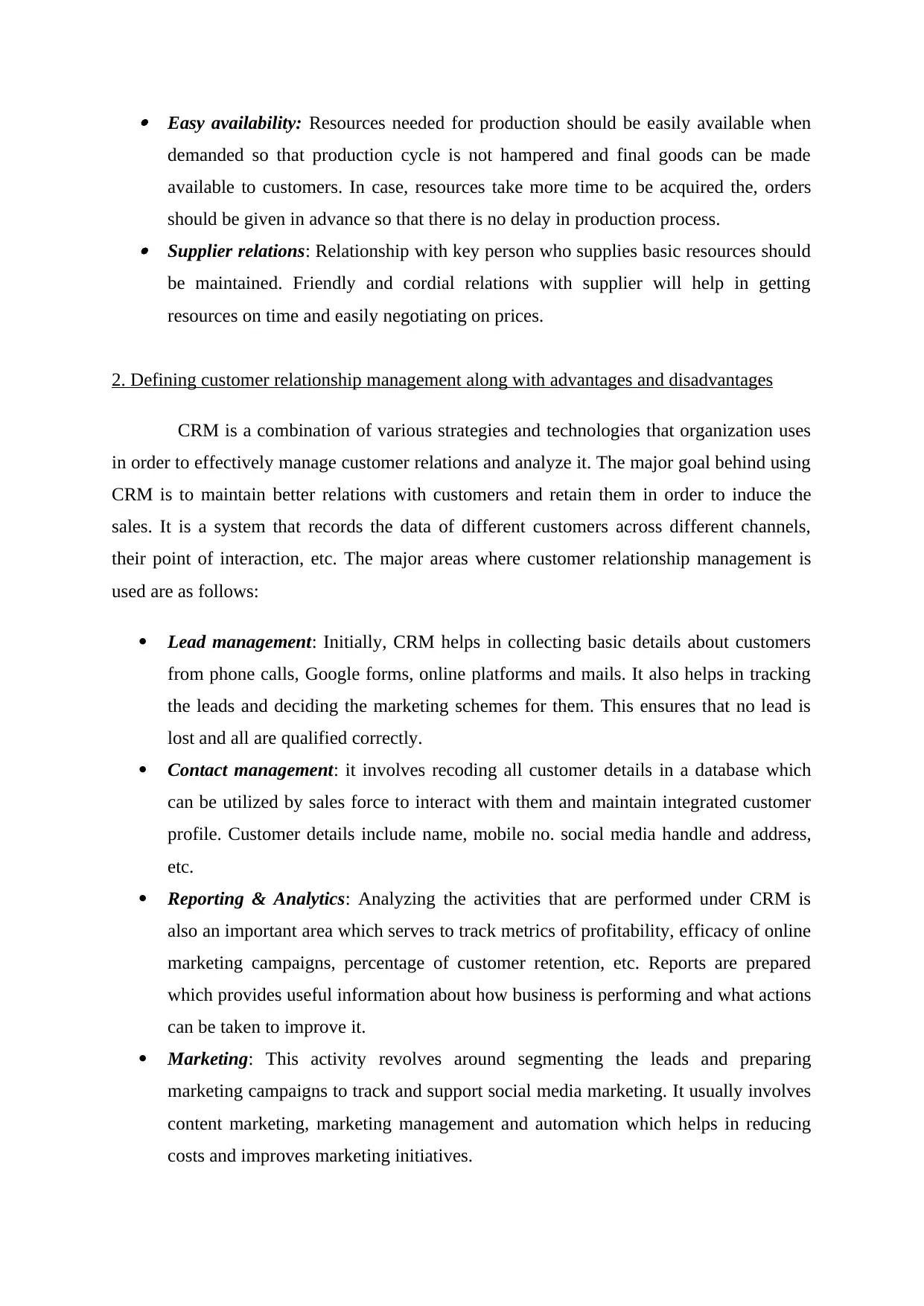
Easy availability: Resources needed for production should be easily available when
demanded so that production cycle is not hampered and final goods can be made
available to customers. In case, resources take more time to be acquired the, orders
should be given in advance so that there is no delay in production process. Supplier relations: Relationship with key person who supplies basic resources should
be maintained. Friendly and cordial relations with supplier will help in getting
resources on time and easily negotiating on prices.
2. Defining customer relationship management along with advantages and disadvantages
CRM is a combination of various strategies and technologies that organization uses
in order to effectively manage customer relations and analyze it. The major goal behind using
CRM is to maintain better relations with customers and retain them in order to induce the
sales. It is a system that records the data of different customers across different channels,
their point of interaction, etc. The major areas where customer relationship management is
used are as follows:
Lead management: Initially, CRM helps in collecting basic details about customers
from phone calls, Google forms, online platforms and mails. It also helps in tracking
the leads and deciding the marketing schemes for them. This ensures that no lead is
lost and all are qualified correctly.
Contact management: it involves recoding all customer details in a database which
can be utilized by sales force to interact with them and maintain integrated customer
profile. Customer details include name, mobile no. social media handle and address,
etc.
Reporting & Analytics: Analyzing the activities that are performed under CRM is
also an important area which serves to track metrics of profitability, efficacy of online
marketing campaigns, percentage of customer retention, etc. Reports are prepared
which provides useful information about how business is performing and what actions
can be taken to improve it.
Marketing: This activity revolves around segmenting the leads and preparing
marketing campaigns to track and support social media marketing. It usually involves
content marketing, marketing management and automation which helps in reducing
costs and improves marketing initiatives.
demanded so that production cycle is not hampered and final goods can be made
available to customers. In case, resources take more time to be acquired the, orders
should be given in advance so that there is no delay in production process. Supplier relations: Relationship with key person who supplies basic resources should
be maintained. Friendly and cordial relations with supplier will help in getting
resources on time and easily negotiating on prices.
2. Defining customer relationship management along with advantages and disadvantages
CRM is a combination of various strategies and technologies that organization uses
in order to effectively manage customer relations and analyze it. The major goal behind using
CRM is to maintain better relations with customers and retain them in order to induce the
sales. It is a system that records the data of different customers across different channels,
their point of interaction, etc. The major areas where customer relationship management is
used are as follows:
Lead management: Initially, CRM helps in collecting basic details about customers
from phone calls, Google forms, online platforms and mails. It also helps in tracking
the leads and deciding the marketing schemes for them. This ensures that no lead is
lost and all are qualified correctly.
Contact management: it involves recoding all customer details in a database which
can be utilized by sales force to interact with them and maintain integrated customer
profile. Customer details include name, mobile no. social media handle and address,
etc.
Reporting & Analytics: Analyzing the activities that are performed under CRM is
also an important area which serves to track metrics of profitability, efficacy of online
marketing campaigns, percentage of customer retention, etc. Reports are prepared
which provides useful information about how business is performing and what actions
can be taken to improve it.
Marketing: This activity revolves around segmenting the leads and preparing
marketing campaigns to track and support social media marketing. It usually involves
content marketing, marketing management and automation which helps in reducing
costs and improves marketing initiatives.
Secure Best Marks with AI Grader
Need help grading? Try our AI Grader for instant feedback on your assignments.
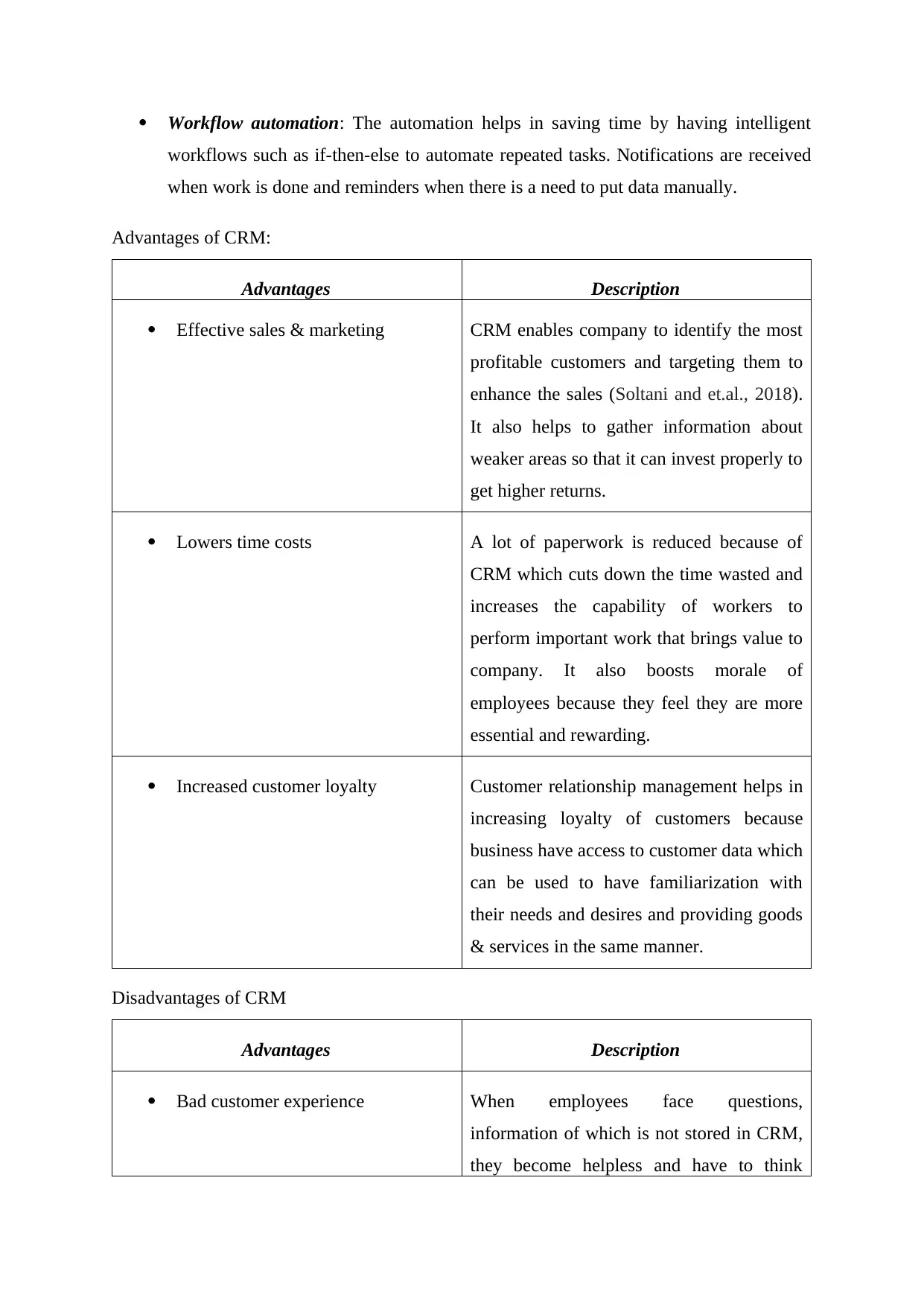
Workflow automation: The automation helps in saving time by having intelligent
workflows such as if-then-else to automate repeated tasks. Notifications are received
when work is done and reminders when there is a need to put data manually.
Advantages of CRM:
Advantages Description
Effective sales & marketing CRM enables company to identify the most
profitable customers and targeting them to
enhance the sales (Soltani and et.al., 2018).
It also helps to gather information about
weaker areas so that it can invest properly to
get higher returns.
Lowers time costs A lot of paperwork is reduced because of
CRM which cuts down the time wasted and
increases the capability of workers to
perform important work that brings value to
company. It also boosts morale of
employees because they feel they are more
essential and rewarding.
Increased customer loyalty Customer relationship management helps in
increasing loyalty of customers because
business have access to customer data which
can be used to have familiarization with
their needs and desires and providing goods
& services in the same manner.
Disadvantages of CRM
Advantages Description
Bad customer experience When employees face questions,
information of which is not stored in CRM,
they become helpless and have to think
workflows such as if-then-else to automate repeated tasks. Notifications are received
when work is done and reminders when there is a need to put data manually.
Advantages of CRM:
Advantages Description
Effective sales & marketing CRM enables company to identify the most
profitable customers and targeting them to
enhance the sales (Soltani and et.al., 2018).
It also helps to gather information about
weaker areas so that it can invest properly to
get higher returns.
Lowers time costs A lot of paperwork is reduced because of
CRM which cuts down the time wasted and
increases the capability of workers to
perform important work that brings value to
company. It also boosts morale of
employees because they feel they are more
essential and rewarding.
Increased customer loyalty Customer relationship management helps in
increasing loyalty of customers because
business have access to customer data which
can be used to have familiarization with
their needs and desires and providing goods
& services in the same manner.
Disadvantages of CRM
Advantages Description
Bad customer experience When employees face questions,
information of which is not stored in CRM,
they become helpless and have to think
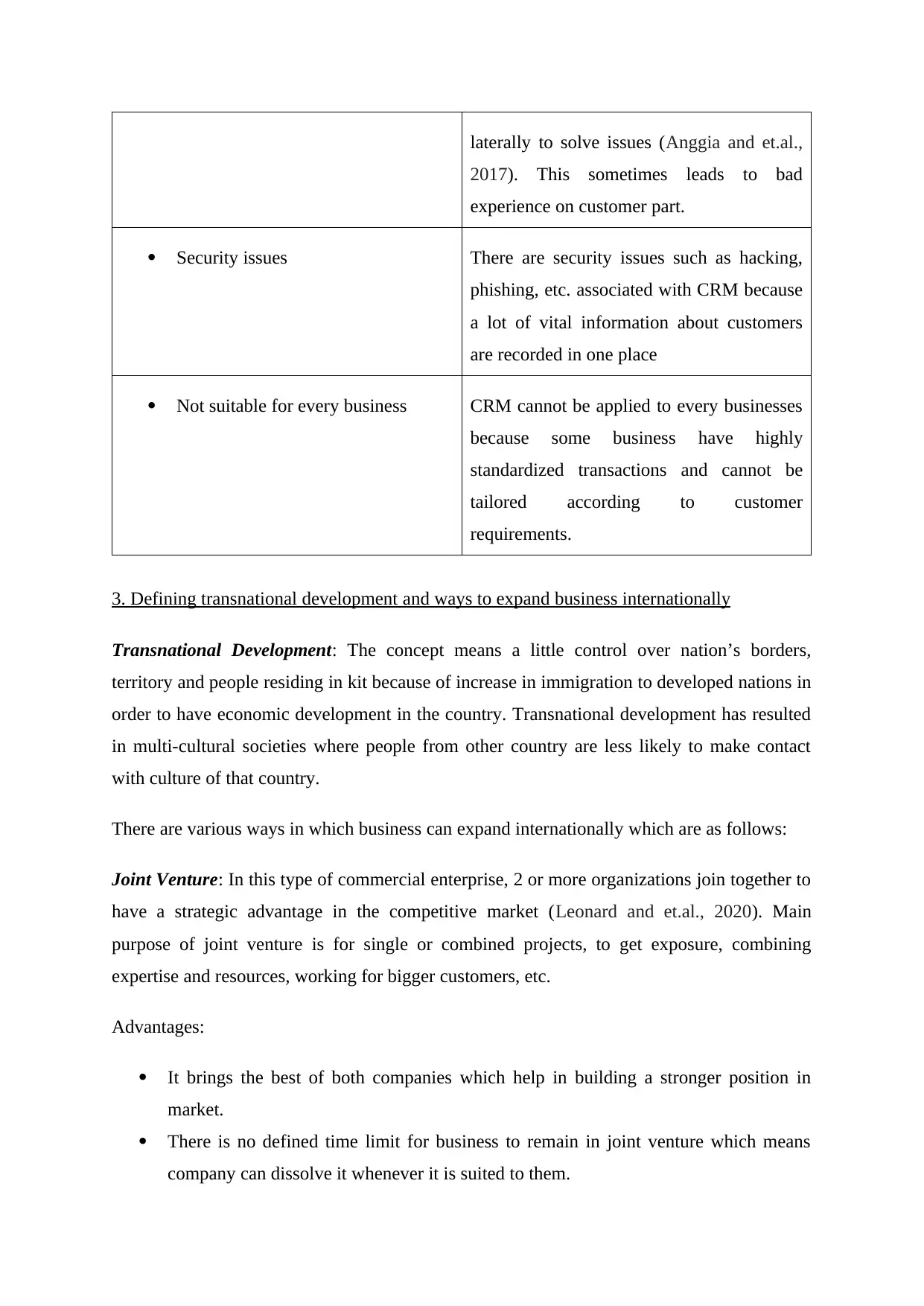
laterally to solve issues (Anggia and et.al.,
2017). This sometimes leads to bad
experience on customer part.
Security issues There are security issues such as hacking,
phishing, etc. associated with CRM because
a lot of vital information about customers
are recorded in one place
Not suitable for every business CRM cannot be applied to every businesses
because some business have highly
standardized transactions and cannot be
tailored according to customer
requirements.
3. Defining transnational development and ways to expand business internationally
Transnational Development: The concept means a little control over nation’s borders,
territory and people residing in kit because of increase in immigration to developed nations in
order to have economic development in the country. Transnational development has resulted
in multi-cultural societies where people from other country are less likely to make contact
with culture of that country.
There are various ways in which business can expand internationally which are as follows:
Joint Venture: In this type of commercial enterprise, 2 or more organizations join together to
have a strategic advantage in the competitive market (Leonard and et.al., 2020). Main
purpose of joint venture is for single or combined projects, to get exposure, combining
expertise and resources, working for bigger customers, etc.
Advantages:
It brings the best of both companies which help in building a stronger position in
market.
There is no defined time limit for business to remain in joint venture which means
company can dissolve it whenever it is suited to them.
2017). This sometimes leads to bad
experience on customer part.
Security issues There are security issues such as hacking,
phishing, etc. associated with CRM because
a lot of vital information about customers
are recorded in one place
Not suitable for every business CRM cannot be applied to every businesses
because some business have highly
standardized transactions and cannot be
tailored according to customer
requirements.
3. Defining transnational development and ways to expand business internationally
Transnational Development: The concept means a little control over nation’s borders,
territory and people residing in kit because of increase in immigration to developed nations in
order to have economic development in the country. Transnational development has resulted
in multi-cultural societies where people from other country are less likely to make contact
with culture of that country.
There are various ways in which business can expand internationally which are as follows:
Joint Venture: In this type of commercial enterprise, 2 or more organizations join together to
have a strategic advantage in the competitive market (Leonard and et.al., 2020). Main
purpose of joint venture is for single or combined projects, to get exposure, combining
expertise and resources, working for bigger customers, etc.
Advantages:
It brings the best of both companies which help in building a stronger position in
market.
There is no defined time limit for business to remain in joint venture which means
company can dissolve it whenever it is suited to them.
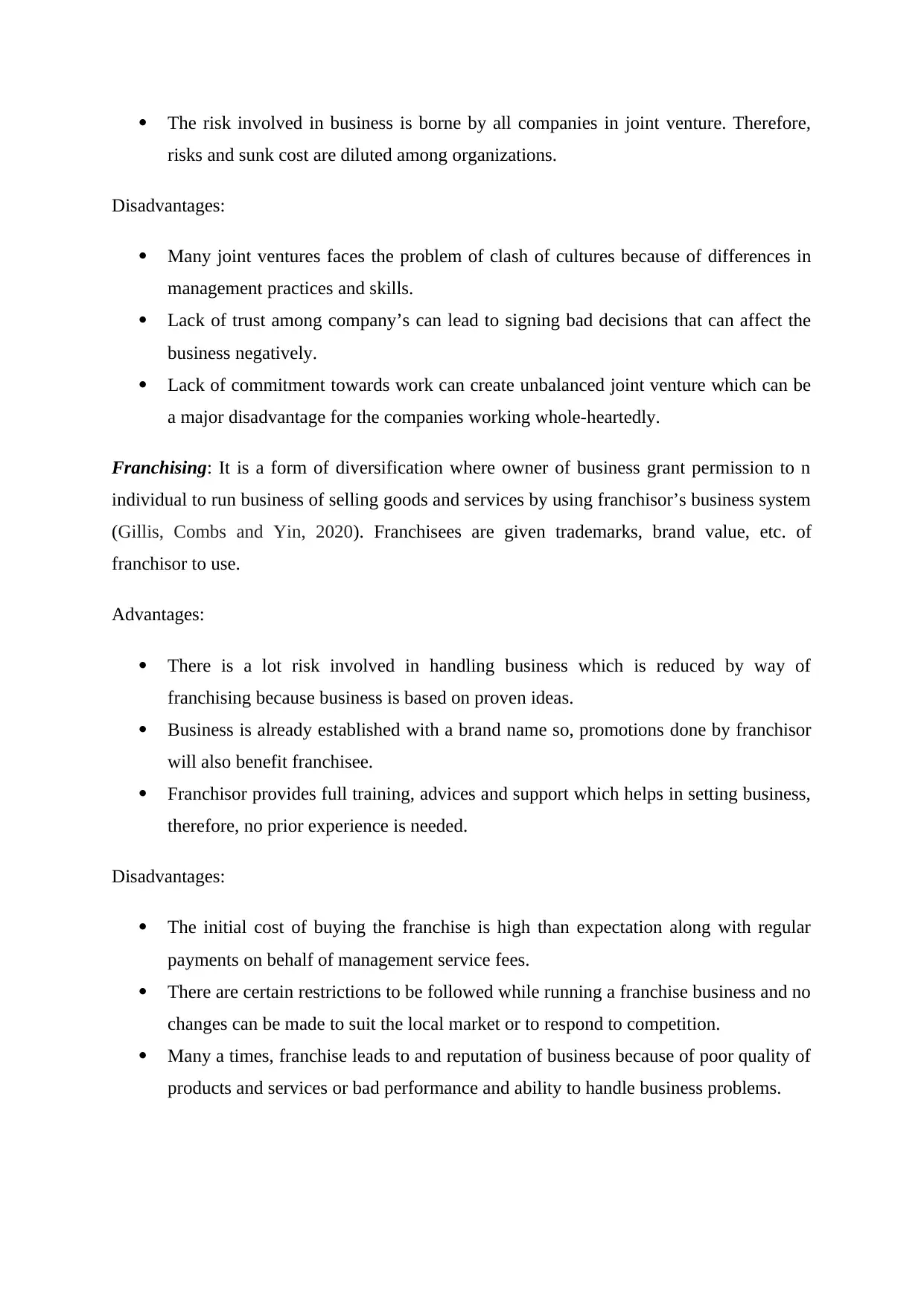
The risk involved in business is borne by all companies in joint venture. Therefore,
risks and sunk cost are diluted among organizations.
Disadvantages:
Many joint ventures faces the problem of clash of cultures because of differences in
management practices and skills.
Lack of trust among company’s can lead to signing bad decisions that can affect the
business negatively.
Lack of commitment towards work can create unbalanced joint venture which can be
a major disadvantage for the companies working whole-heartedly.
Franchising: It is a form of diversification where owner of business grant permission to n
individual to run business of selling goods and services by using franchisor’s business system
(Gillis, Combs and Yin, 2020). Franchisees are given trademarks, brand value, etc. of
franchisor to use.
Advantages:
There is a lot risk involved in handling business which is reduced by way of
franchising because business is based on proven ideas.
Business is already established with a brand name so, promotions done by franchisor
will also benefit franchisee.
Franchisor provides full training, advices and support which helps in setting business,
therefore, no prior experience is needed.
Disadvantages:
The initial cost of buying the franchise is high than expectation along with regular
payments on behalf of management service fees.
There are certain restrictions to be followed while running a franchise business and no
changes can be made to suit the local market or to respond to competition.
Many a times, franchise leads to and reputation of business because of poor quality of
products and services or bad performance and ability to handle business problems.
risks and sunk cost are diluted among organizations.
Disadvantages:
Many joint ventures faces the problem of clash of cultures because of differences in
management practices and skills.
Lack of trust among company’s can lead to signing bad decisions that can affect the
business negatively.
Lack of commitment towards work can create unbalanced joint venture which can be
a major disadvantage for the companies working whole-heartedly.
Franchising: It is a form of diversification where owner of business grant permission to n
individual to run business of selling goods and services by using franchisor’s business system
(Gillis, Combs and Yin, 2020). Franchisees are given trademarks, brand value, etc. of
franchisor to use.
Advantages:
There is a lot risk involved in handling business which is reduced by way of
franchising because business is based on proven ideas.
Business is already established with a brand name so, promotions done by franchisor
will also benefit franchisee.
Franchisor provides full training, advices and support which helps in setting business,
therefore, no prior experience is needed.
Disadvantages:
The initial cost of buying the franchise is high than expectation along with regular
payments on behalf of management service fees.
There are certain restrictions to be followed while running a franchise business and no
changes can be made to suit the local market or to respond to competition.
Many a times, franchise leads to and reputation of business because of poor quality of
products and services or bad performance and ability to handle business problems.
Paraphrase This Document
Need a fresh take? Get an instant paraphrase of this document with our AI Paraphraser
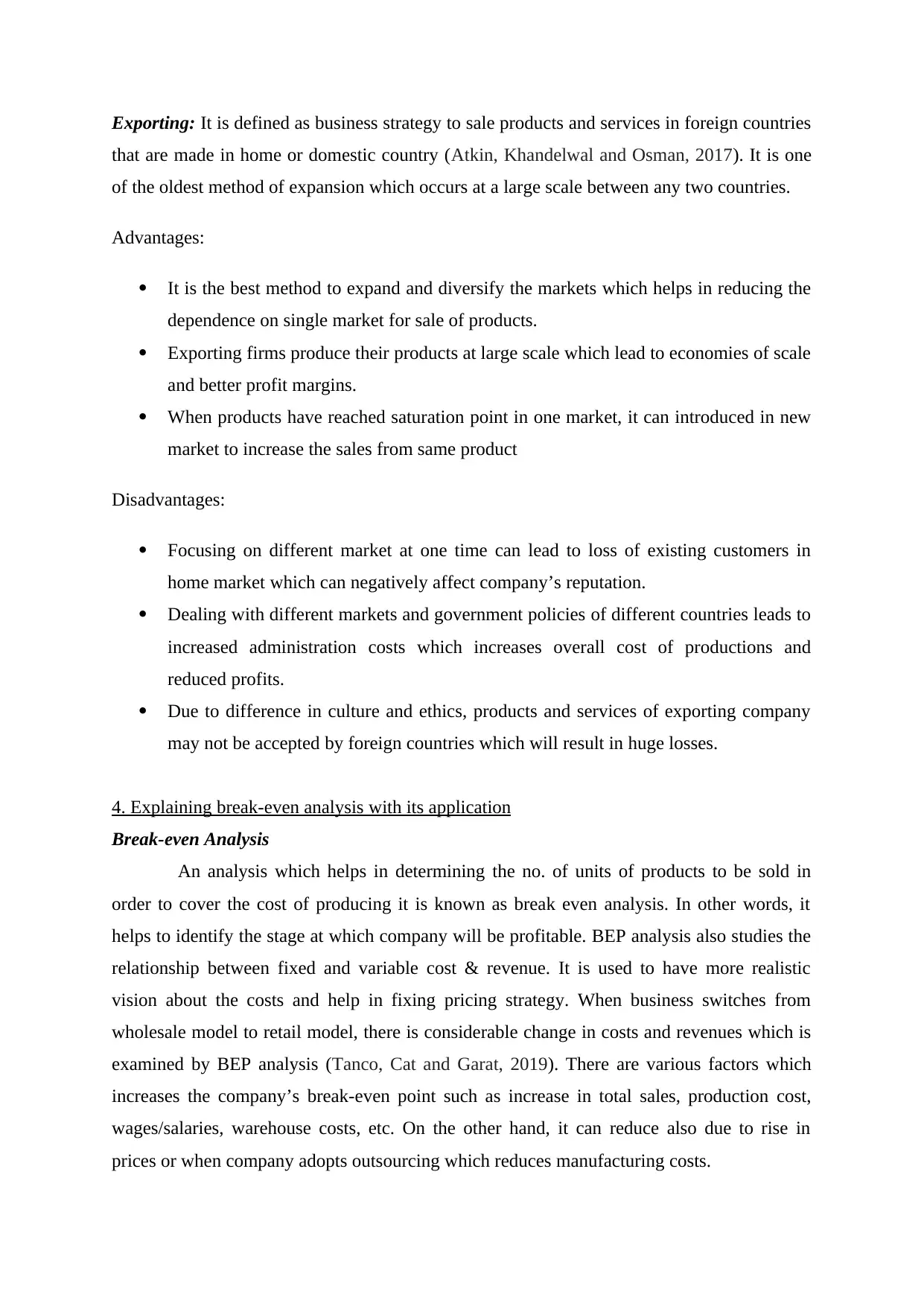
Exporting: It is defined as business strategy to sale products and services in foreign countries
that are made in home or domestic country (Atkin, Khandelwal and Osman, 2017). It is one
of the oldest method of expansion which occurs at a large scale between any two countries.
Advantages:
It is the best method to expand and diversify the markets which helps in reducing the
dependence on single market for sale of products.
Exporting firms produce their products at large scale which lead to economies of scale
and better profit margins.
When products have reached saturation point in one market, it can introduced in new
market to increase the sales from same product
Disadvantages:
Focusing on different market at one time can lead to loss of existing customers in
home market which can negatively affect company’s reputation.
Dealing with different markets and government policies of different countries leads to
increased administration costs which increases overall cost of productions and
reduced profits.
Due to difference in culture and ethics, products and services of exporting company
may not be accepted by foreign countries which will result in huge losses.
4. Explaining break-even analysis with its application
Break-even Analysis
An analysis which helps in determining the no. of units of products to be sold in
order to cover the cost of producing it is known as break even analysis. In other words, it
helps to identify the stage at which company will be profitable. BEP analysis also studies the
relationship between fixed and variable cost & revenue. It is used to have more realistic
vision about the costs and help in fixing pricing strategy. When business switches from
wholesale model to retail model, there is considerable change in costs and revenues which is
examined by BEP analysis (Tanco, Cat and Garat, 2019). There are various factors which
increases the company’s break-even point such as increase in total sales, production cost,
wages/salaries, warehouse costs, etc. On the other hand, it can reduce also due to rise in
prices or when company adopts outsourcing which reduces manufacturing costs.
that are made in home or domestic country (Atkin, Khandelwal and Osman, 2017). It is one
of the oldest method of expansion which occurs at a large scale between any two countries.
Advantages:
It is the best method to expand and diversify the markets which helps in reducing the
dependence on single market for sale of products.
Exporting firms produce their products at large scale which lead to economies of scale
and better profit margins.
When products have reached saturation point in one market, it can introduced in new
market to increase the sales from same product
Disadvantages:
Focusing on different market at one time can lead to loss of existing customers in
home market which can negatively affect company’s reputation.
Dealing with different markets and government policies of different countries leads to
increased administration costs which increases overall cost of productions and
reduced profits.
Due to difference in culture and ethics, products and services of exporting company
may not be accepted by foreign countries which will result in huge losses.
4. Explaining break-even analysis with its application
Break-even Analysis
An analysis which helps in determining the no. of units of products to be sold in
order to cover the cost of producing it is known as break even analysis. In other words, it
helps to identify the stage at which company will be profitable. BEP analysis also studies the
relationship between fixed and variable cost & revenue. It is used to have more realistic
vision about the costs and help in fixing pricing strategy. When business switches from
wholesale model to retail model, there is considerable change in costs and revenues which is
examined by BEP analysis (Tanco, Cat and Garat, 2019). There are various factors which
increases the company’s break-even point such as increase in total sales, production cost,
wages/salaries, warehouse costs, etc. On the other hand, it can reduce also due to rise in
prices or when company adopts outsourcing which reduces manufacturing costs.
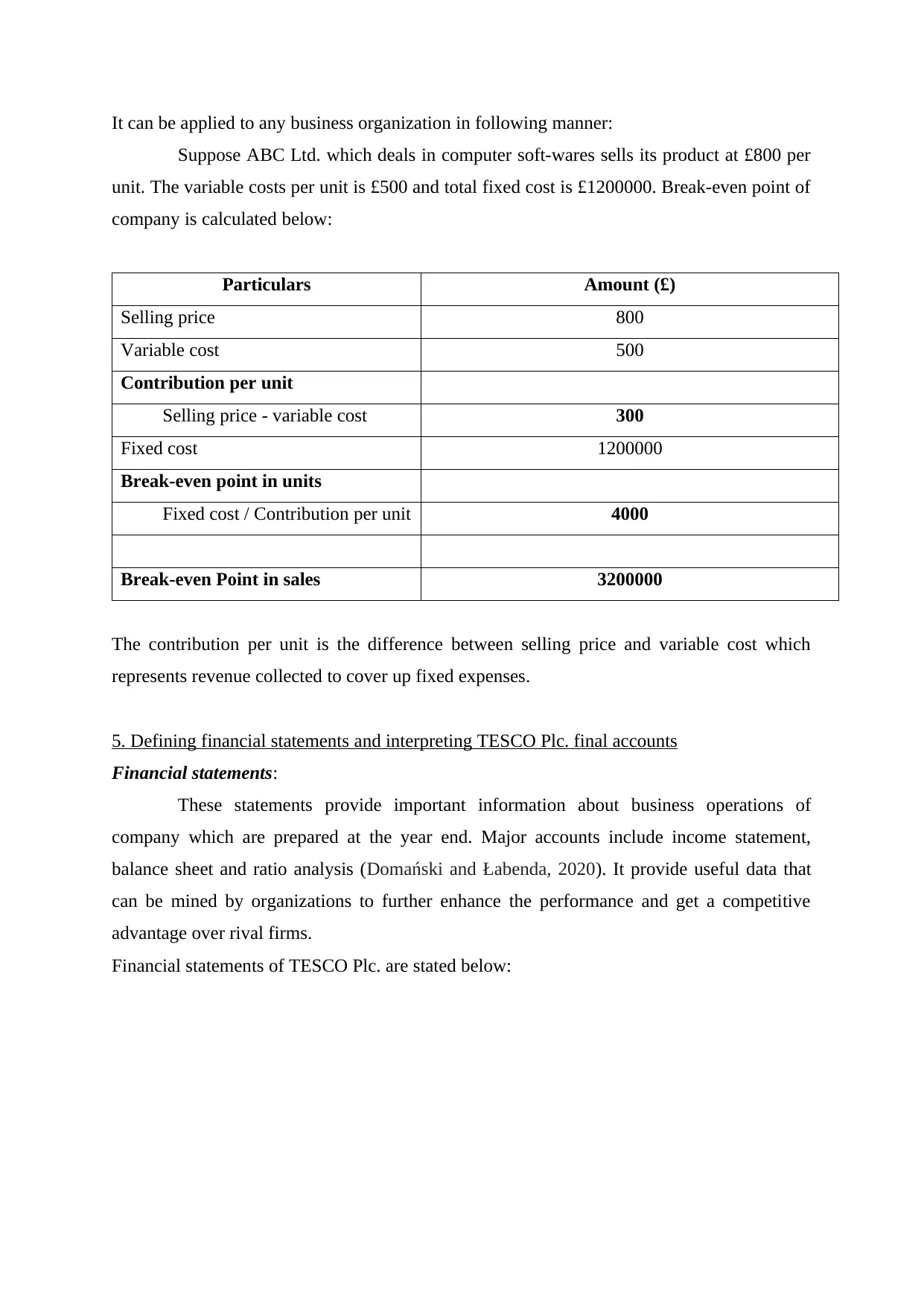
It can be applied to any business organization in following manner:
Suppose ABC Ltd. which deals in computer soft-wares sells its product at £800 per
unit. The variable costs per unit is £500 and total fixed cost is £1200000. Break-even point of
company is calculated below:
Particulars Amount (£)
Selling price 800
Variable cost 500
Contribution per unit
Selling price - variable cost 300
Fixed cost 1200000
Break-even point in units
Fixed cost / Contribution per unit 4000
Break-even Point in sales 3200000
The contribution per unit is the difference between selling price and variable cost which
represents revenue collected to cover up fixed expenses.
5. Defining financial statements and interpreting TESCO Plc. final accounts
Financial statements:
These statements provide important information about business operations of
company which are prepared at the year end. Major accounts include income statement,
balance sheet and ratio analysis (Domański and Łabenda, 2020). It provide useful data that
can be mined by organizations to further enhance the performance and get a competitive
advantage over rival firms.
Financial statements of TESCO Plc. are stated below:
Suppose ABC Ltd. which deals in computer soft-wares sells its product at £800 per
unit. The variable costs per unit is £500 and total fixed cost is £1200000. Break-even point of
company is calculated below:
Particulars Amount (£)
Selling price 800
Variable cost 500
Contribution per unit
Selling price - variable cost 300
Fixed cost 1200000
Break-even point in units
Fixed cost / Contribution per unit 4000
Break-even Point in sales 3200000
The contribution per unit is the difference between selling price and variable cost which
represents revenue collected to cover up fixed expenses.
5. Defining financial statements and interpreting TESCO Plc. final accounts
Financial statements:
These statements provide important information about business operations of
company which are prepared at the year end. Major accounts include income statement,
balance sheet and ratio analysis (Domański and Łabenda, 2020). It provide useful data that
can be mined by organizations to further enhance the performance and get a competitive
advantage over rival firms.
Financial statements of TESCO Plc. are stated below:
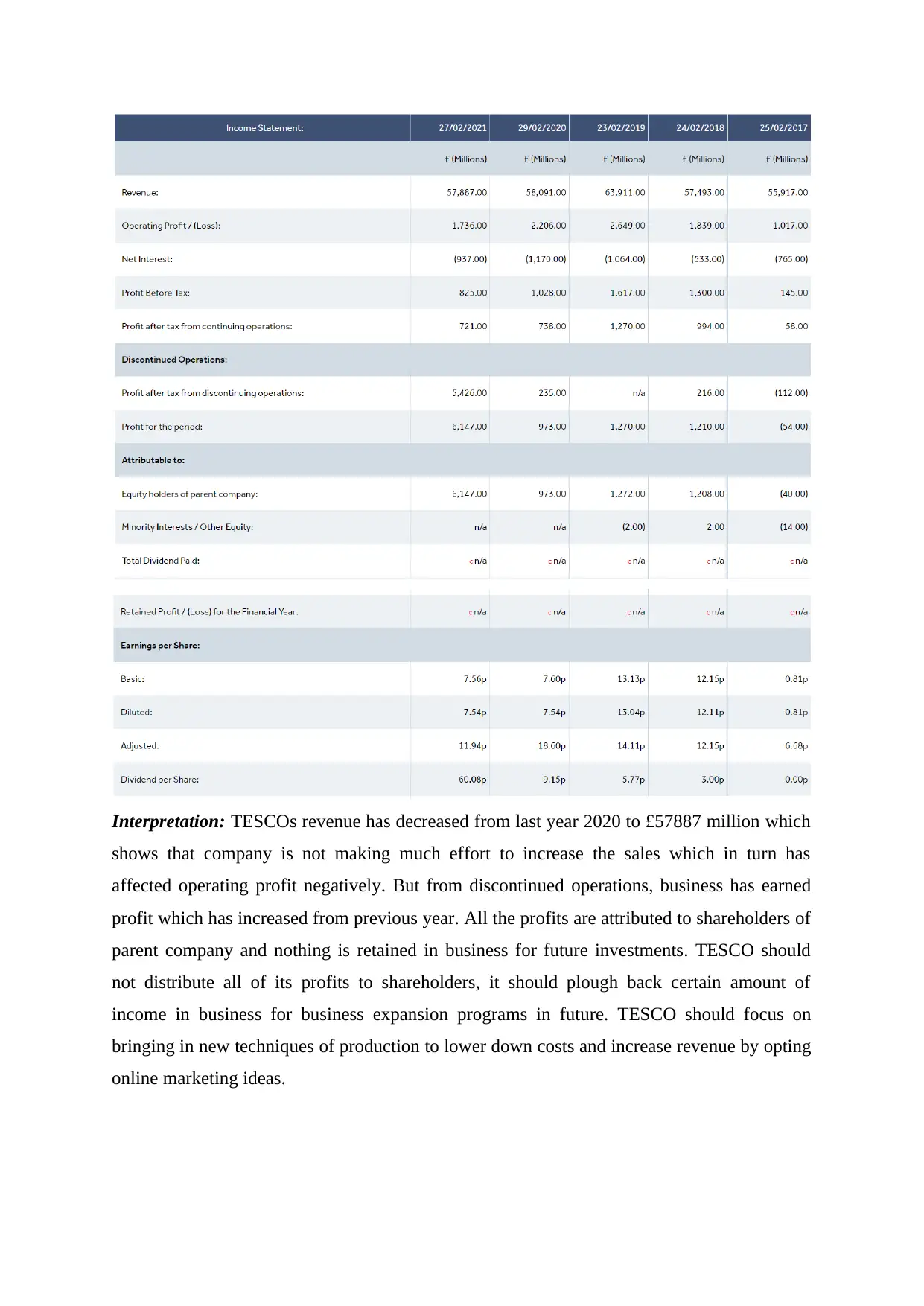
Interpretation: TESCOs revenue has decreased from last year 2020 to £57887 million which
shows that company is not making much effort to increase the sales which in turn has
affected operating profit negatively. But from discontinued operations, business has earned
profit which has increased from previous year. All the profits are attributed to shareholders of
parent company and nothing is retained in business for future investments. TESCO should
not distribute all of its profits to shareholders, it should plough back certain amount of
income in business for business expansion programs in future. TESCO should focus on
bringing in new techniques of production to lower down costs and increase revenue by opting
online marketing ideas.
shows that company is not making much effort to increase the sales which in turn has
affected operating profit negatively. But from discontinued operations, business has earned
profit which has increased from previous year. All the profits are attributed to shareholders of
parent company and nothing is retained in business for future investments. TESCO should
not distribute all of its profits to shareholders, it should plough back certain amount of
income in business for business expansion programs in future. TESCO should focus on
bringing in new techniques of production to lower down costs and increase revenue by opting
online marketing ideas.
Secure Best Marks with AI Grader
Need help grading? Try our AI Grader for instant feedback on your assignments.
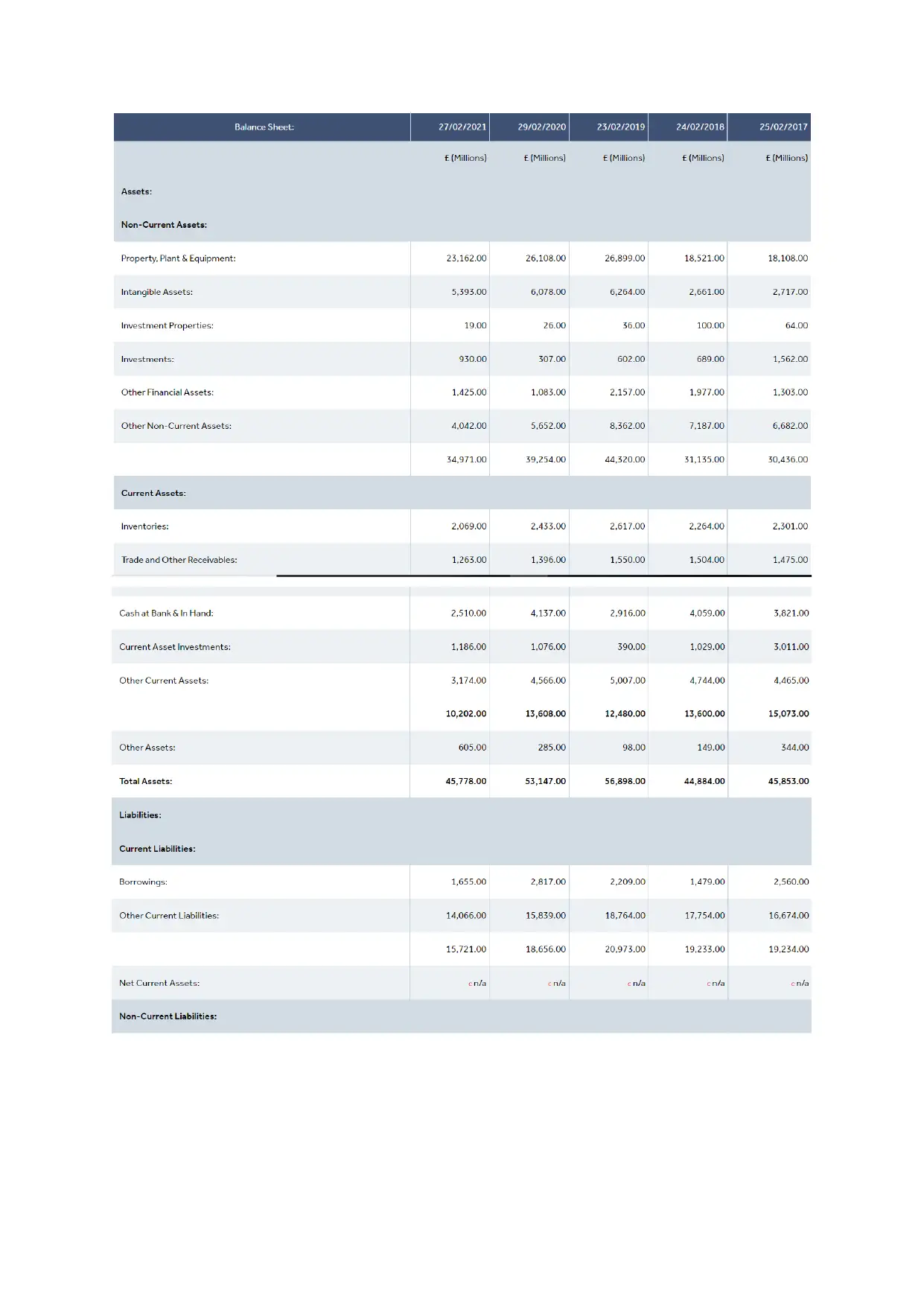
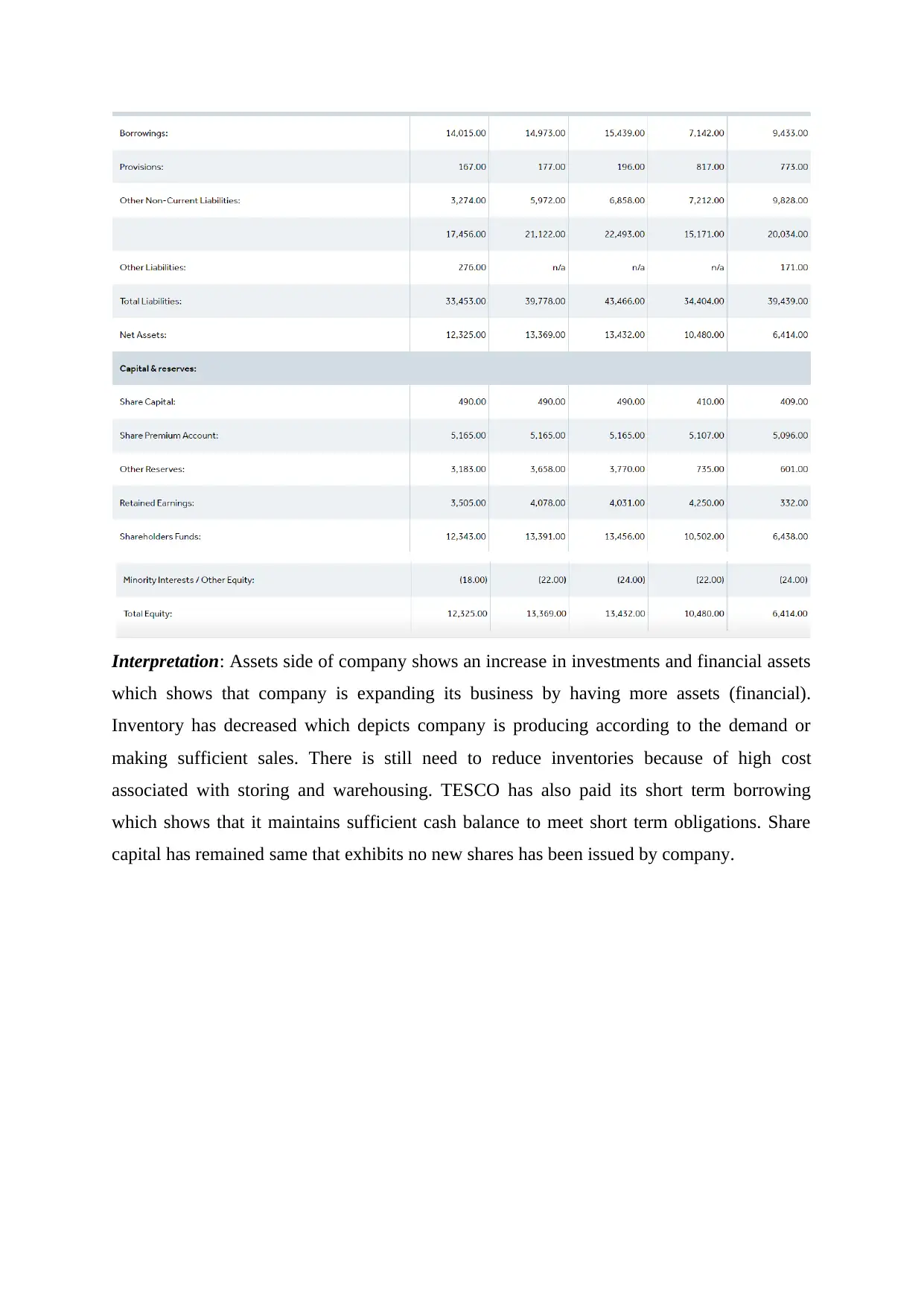
Interpretation: Assets side of company shows an increase in investments and financial assets
which shows that company is expanding its business by having more assets (financial).
Inventory has decreased which depicts company is producing according to the demand or
making sufficient sales. There is still need to reduce inventories because of high cost
associated with storing and warehousing. TESCO has also paid its short term borrowing
which shows that it maintains sufficient cash balance to meet short term obligations. Share
capital has remained same that exhibits no new shares has been issued by company.
which shows that company is expanding its business by having more assets (financial).
Inventory has decreased which depicts company is producing according to the demand or
making sufficient sales. There is still need to reduce inventories because of high cost
associated with storing and warehousing. TESCO has also paid its short term borrowing
which shows that it maintains sufficient cash balance to meet short term obligations. Share
capital has remained same that exhibits no new shares has been issued by company.
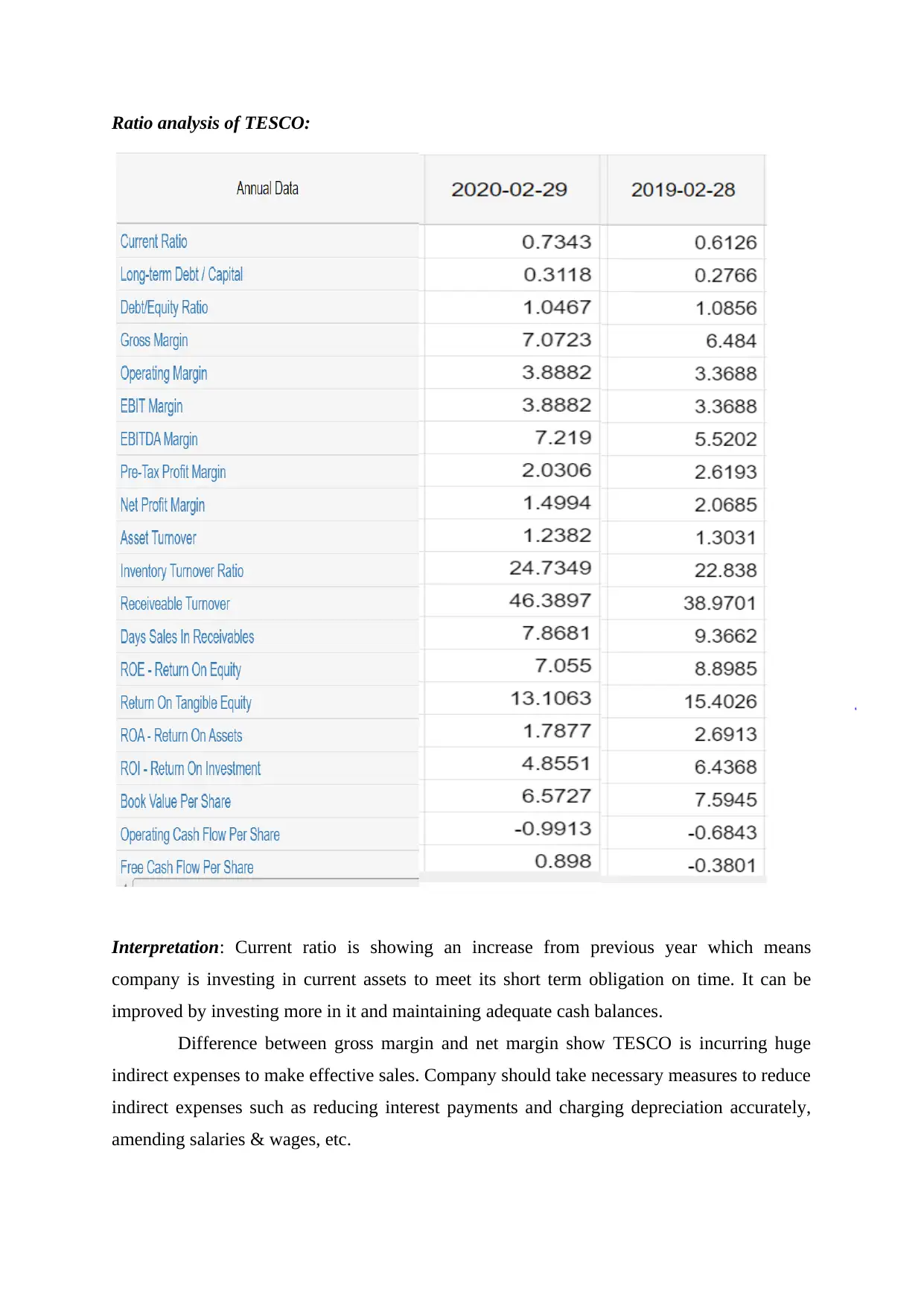
Ratio analysis of TESCO:
Interpretation: Current ratio is showing an increase from previous year which means
company is investing in current assets to meet its short term obligation on time. It can be
improved by investing more in it and maintaining adequate cash balances.
Difference between gross margin and net margin show TESCO is incurring huge
indirect expenses to make effective sales. Company should take necessary measures to reduce
indirect expenses such as reducing interest payments and charging depreciation accurately,
amending salaries & wages, etc.
Interpretation: Current ratio is showing an increase from previous year which means
company is investing in current assets to meet its short term obligation on time. It can be
improved by investing more in it and maintaining adequate cash balances.
Difference between gross margin and net margin show TESCO is incurring huge
indirect expenses to make effective sales. Company should take necessary measures to reduce
indirect expenses such as reducing interest payments and charging depreciation accurately,
amending salaries & wages, etc.
Paraphrase This Document
Need a fresh take? Get an instant paraphrase of this document with our AI Paraphraser
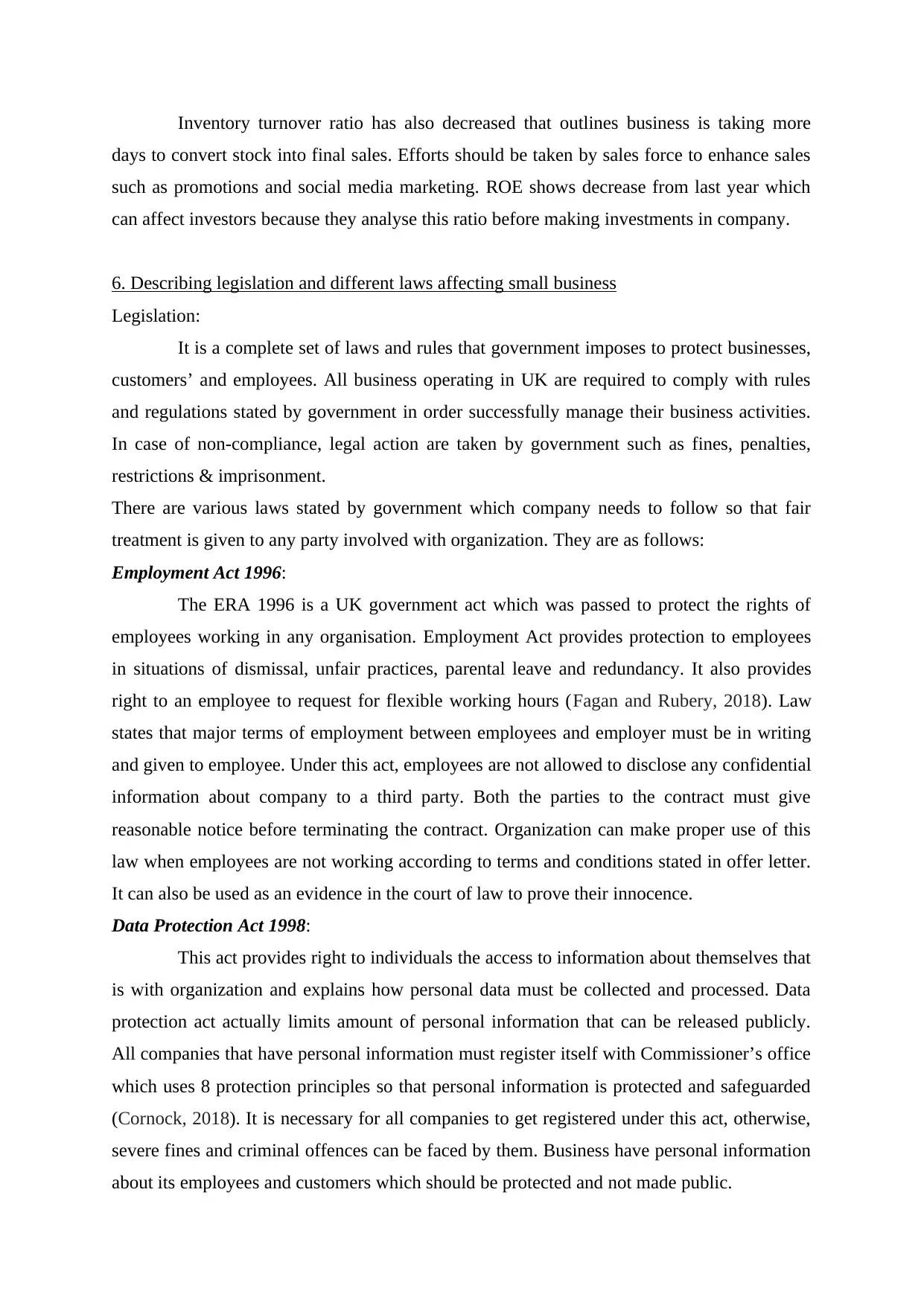
Inventory turnover ratio has also decreased that outlines business is taking more
days to convert stock into final sales. Efforts should be taken by sales force to enhance sales
such as promotions and social media marketing. ROE shows decrease from last year which
can affect investors because they analyse this ratio before making investments in company.
6. Describing legislation and different laws affecting small business
Legislation:
It is a complete set of laws and rules that government imposes to protect businesses,
customers’ and employees. All business operating in UK are required to comply with rules
and regulations stated by government in order successfully manage their business activities.
In case of non-compliance, legal action are taken by government such as fines, penalties,
restrictions & imprisonment.
There are various laws stated by government which company needs to follow so that fair
treatment is given to any party involved with organization. They are as follows:
Employment Act 1996:
The ERA 1996 is a UK government act which was passed to protect the rights of
employees working in any organisation. Employment Act provides protection to employees
in situations of dismissal, unfair practices, parental leave and redundancy. It also provides
right to an employee to request for flexible working hours (Fagan and Rubery, 2018). Law
states that major terms of employment between employees and employer must be in writing
and given to employee. Under this act, employees are not allowed to disclose any confidential
information about company to a third party. Both the parties to the contract must give
reasonable notice before terminating the contract. Organization can make proper use of this
law when employees are not working according to terms and conditions stated in offer letter.
It can also be used as an evidence in the court of law to prove their innocence.
Data Protection Act 1998:
This act provides right to individuals the access to information about themselves that
is with organization and explains how personal data must be collected and processed. Data
protection act actually limits amount of personal information that can be released publicly.
All companies that have personal information must register itself with Commissioner’s office
which uses 8 protection principles so that personal information is protected and safeguarded
(Cornock, 2018). It is necessary for all companies to get registered under this act, otherwise,
severe fines and criminal offences can be faced by them. Business have personal information
about its employees and customers which should be protected and not made public.
days to convert stock into final sales. Efforts should be taken by sales force to enhance sales
such as promotions and social media marketing. ROE shows decrease from last year which
can affect investors because they analyse this ratio before making investments in company.
6. Describing legislation and different laws affecting small business
Legislation:
It is a complete set of laws and rules that government imposes to protect businesses,
customers’ and employees. All business operating in UK are required to comply with rules
and regulations stated by government in order successfully manage their business activities.
In case of non-compliance, legal action are taken by government such as fines, penalties,
restrictions & imprisonment.
There are various laws stated by government which company needs to follow so that fair
treatment is given to any party involved with organization. They are as follows:
Employment Act 1996:
The ERA 1996 is a UK government act which was passed to protect the rights of
employees working in any organisation. Employment Act provides protection to employees
in situations of dismissal, unfair practices, parental leave and redundancy. It also provides
right to an employee to request for flexible working hours (Fagan and Rubery, 2018). Law
states that major terms of employment between employees and employer must be in writing
and given to employee. Under this act, employees are not allowed to disclose any confidential
information about company to a third party. Both the parties to the contract must give
reasonable notice before terminating the contract. Organization can make proper use of this
law when employees are not working according to terms and conditions stated in offer letter.
It can also be used as an evidence in the court of law to prove their innocence.
Data Protection Act 1998:
This act provides right to individuals the access to information about themselves that
is with organization and explains how personal data must be collected and processed. Data
protection act actually limits amount of personal information that can be released publicly.
All companies that have personal information must register itself with Commissioner’s office
which uses 8 protection principles so that personal information is protected and safeguarded
(Cornock, 2018). It is necessary for all companies to get registered under this act, otherwise,
severe fines and criminal offences can be faced by them. Business have personal information
about its employees and customers which should be protected and not made public.
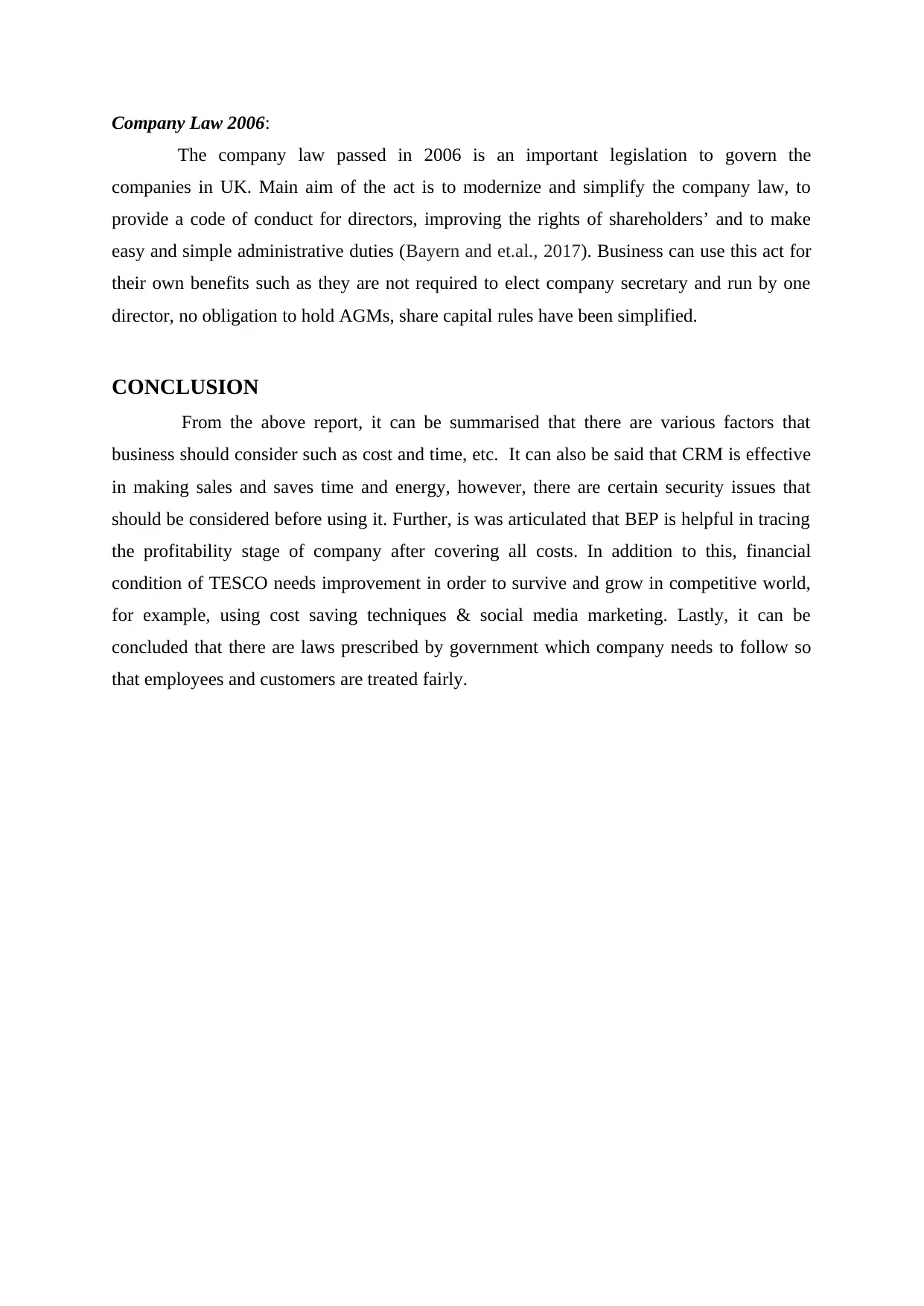
Company Law 2006:
The company law passed in 2006 is an important legislation to govern the
companies in UK. Main aim of the act is to modernize and simplify the company law, to
provide a code of conduct for directors, improving the rights of shareholders’ and to make
easy and simple administrative duties (Bayern and et.al., 2017). Business can use this act for
their own benefits such as they are not required to elect company secretary and run by one
director, no obligation to hold AGMs, share capital rules have been simplified.
CONCLUSION
From the above report, it can be summarised that there are various factors that
business should consider such as cost and time, etc. It can also be said that CRM is effective
in making sales and saves time and energy, however, there are certain security issues that
should be considered before using it. Further, is was articulated that BEP is helpful in tracing
the profitability stage of company after covering all costs. In addition to this, financial
condition of TESCO needs improvement in order to survive and grow in competitive world,
for example, using cost saving techniques & social media marketing. Lastly, it can be
concluded that there are laws prescribed by government which company needs to follow so
that employees and customers are treated fairly.
The company law passed in 2006 is an important legislation to govern the
companies in UK. Main aim of the act is to modernize and simplify the company law, to
provide a code of conduct for directors, improving the rights of shareholders’ and to make
easy and simple administrative duties (Bayern and et.al., 2017). Business can use this act for
their own benefits such as they are not required to elect company secretary and run by one
director, no obligation to hold AGMs, share capital rules have been simplified.
CONCLUSION
From the above report, it can be summarised that there are various factors that
business should consider such as cost and time, etc. It can also be said that CRM is effective
in making sales and saves time and energy, however, there are certain security issues that
should be considered before using it. Further, is was articulated that BEP is helpful in tracing
the profitability stage of company after covering all costs. In addition to this, financial
condition of TESCO needs improvement in order to survive and grow in competitive world,
for example, using cost saving techniques & social media marketing. Lastly, it can be
concluded that there are laws prescribed by government which company needs to follow so
that employees and customers are treated fairly.
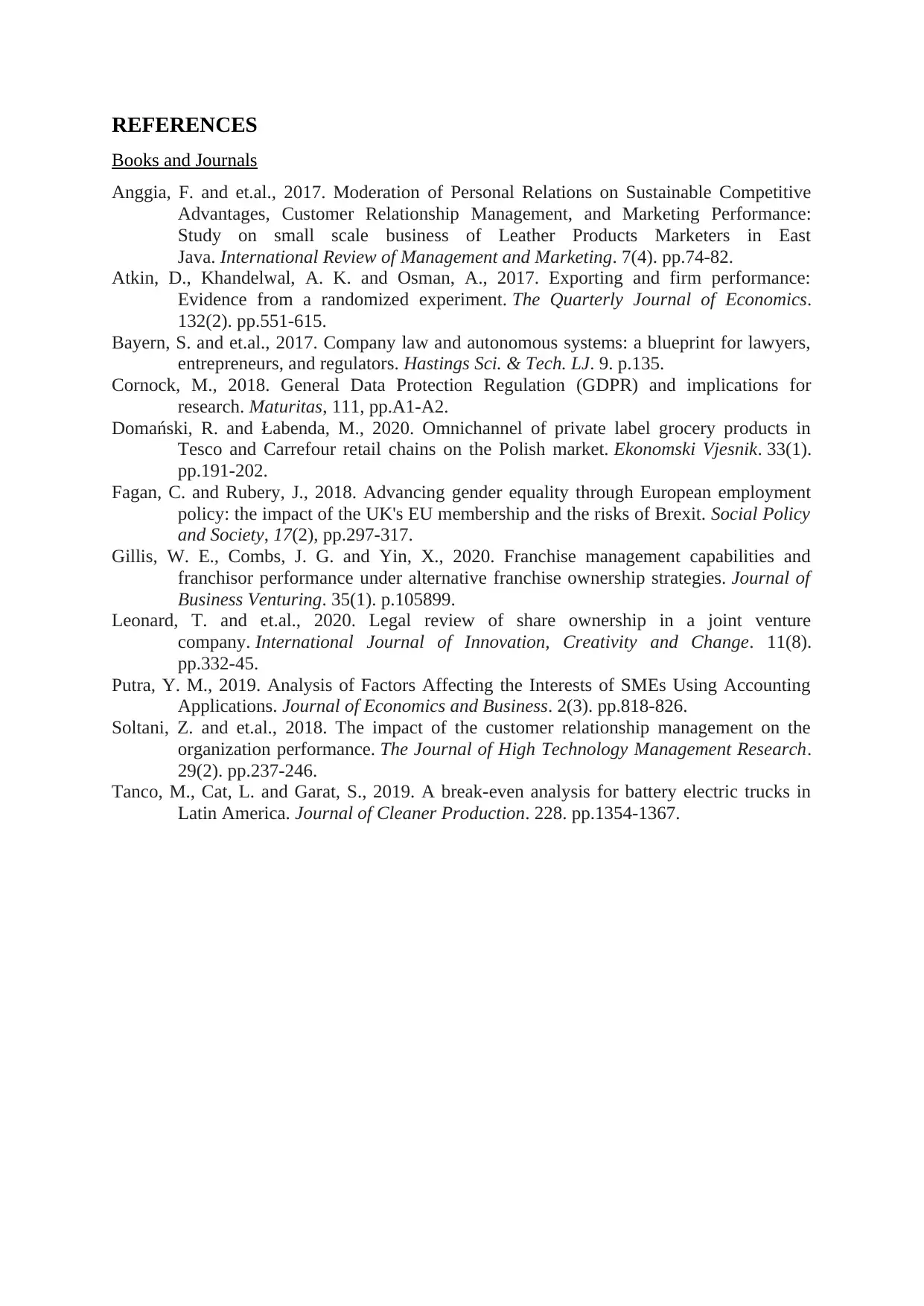
REFERENCES
Books and Journals
Anggia, F. and et.al., 2017. Moderation of Personal Relations on Sustainable Competitive
Advantages, Customer Relationship Management, and Marketing Performance:
Study on small scale business of Leather Products Marketers in East
Java. International Review of Management and Marketing. 7(4). pp.74-82.
Atkin, D., Khandelwal, A. K. and Osman, A., 2017. Exporting and firm performance:
Evidence from a randomized experiment. The Quarterly Journal of Economics.
132(2). pp.551-615.
Bayern, S. and et.al., 2017. Company law and autonomous systems: a blueprint for lawyers,
entrepreneurs, and regulators. Hastings Sci. & Tech. LJ. 9. p.135.
Cornock, M., 2018. General Data Protection Regulation (GDPR) and implications for
research. Maturitas, 111, pp.A1-A2.
Domański, R. and Łabenda, M., 2020. Omnichannel of private label grocery products in
Tesco and Carrefour retail chains on the Polish market. Ekonomski Vjesnik. 33(1).
pp.191-202.
Fagan, C. and Rubery, J., 2018. Advancing gender equality through European employment
policy: the impact of the UK's EU membership and the risks of Brexit. Social Policy
and Society, 17(2), pp.297-317.
Gillis, W. E., Combs, J. G. and Yin, X., 2020. Franchise management capabilities and
franchisor performance under alternative franchise ownership strategies. Journal of
Business Venturing. 35(1). p.105899.
Leonard, T. and et.al., 2020. Legal review of share ownership in a joint venture
company. International Journal of Innovation, Creativity and Change. 11(8).
pp.332-45.
Putra, Y. M., 2019. Analysis of Factors Affecting the Interests of SMEs Using Accounting
Applications. Journal of Economics and Business. 2(3). pp.818-826.
Soltani, Z. and et.al., 2018. The impact of the customer relationship management on the
organization performance. The Journal of High Technology Management Research.
29(2). pp.237-246.
Tanco, M., Cat, L. and Garat, S., 2019. A break-even analysis for battery electric trucks in
Latin America. Journal of Cleaner Production. 228. pp.1354-1367.
Books and Journals
Anggia, F. and et.al., 2017. Moderation of Personal Relations on Sustainable Competitive
Advantages, Customer Relationship Management, and Marketing Performance:
Study on small scale business of Leather Products Marketers in East
Java. International Review of Management and Marketing. 7(4). pp.74-82.
Atkin, D., Khandelwal, A. K. and Osman, A., 2017. Exporting and firm performance:
Evidence from a randomized experiment. The Quarterly Journal of Economics.
132(2). pp.551-615.
Bayern, S. and et.al., 2017. Company law and autonomous systems: a blueprint for lawyers,
entrepreneurs, and regulators. Hastings Sci. & Tech. LJ. 9. p.135.
Cornock, M., 2018. General Data Protection Regulation (GDPR) and implications for
research. Maturitas, 111, pp.A1-A2.
Domański, R. and Łabenda, M., 2020. Omnichannel of private label grocery products in
Tesco and Carrefour retail chains on the Polish market. Ekonomski Vjesnik. 33(1).
pp.191-202.
Fagan, C. and Rubery, J., 2018. Advancing gender equality through European employment
policy: the impact of the UK's EU membership and the risks of Brexit. Social Policy
and Society, 17(2), pp.297-317.
Gillis, W. E., Combs, J. G. and Yin, X., 2020. Franchise management capabilities and
franchisor performance under alternative franchise ownership strategies. Journal of
Business Venturing. 35(1). p.105899.
Leonard, T. and et.al., 2020. Legal review of share ownership in a joint venture
company. International Journal of Innovation, Creativity and Change. 11(8).
pp.332-45.
Putra, Y. M., 2019. Analysis of Factors Affecting the Interests of SMEs Using Accounting
Applications. Journal of Economics and Business. 2(3). pp.818-826.
Soltani, Z. and et.al., 2018. The impact of the customer relationship management on the
organization performance. The Journal of High Technology Management Research.
29(2). pp.237-246.
Tanco, M., Cat, L. and Garat, S., 2019. A break-even analysis for battery electric trucks in
Latin America. Journal of Cleaner Production. 228. pp.1354-1367.
Secure Best Marks with AI Grader
Need help grading? Try our AI Grader for instant feedback on your assignments.

1 out of 17
Related Documents
Your All-in-One AI-Powered Toolkit for Academic Success.
+13062052269
info@desklib.com
Available 24*7 on WhatsApp / Email
![[object Object]](/_next/static/media/star-bottom.7253800d.svg)
Unlock your academic potential
© 2024 | Zucol Services PVT LTD | All rights reserved.





